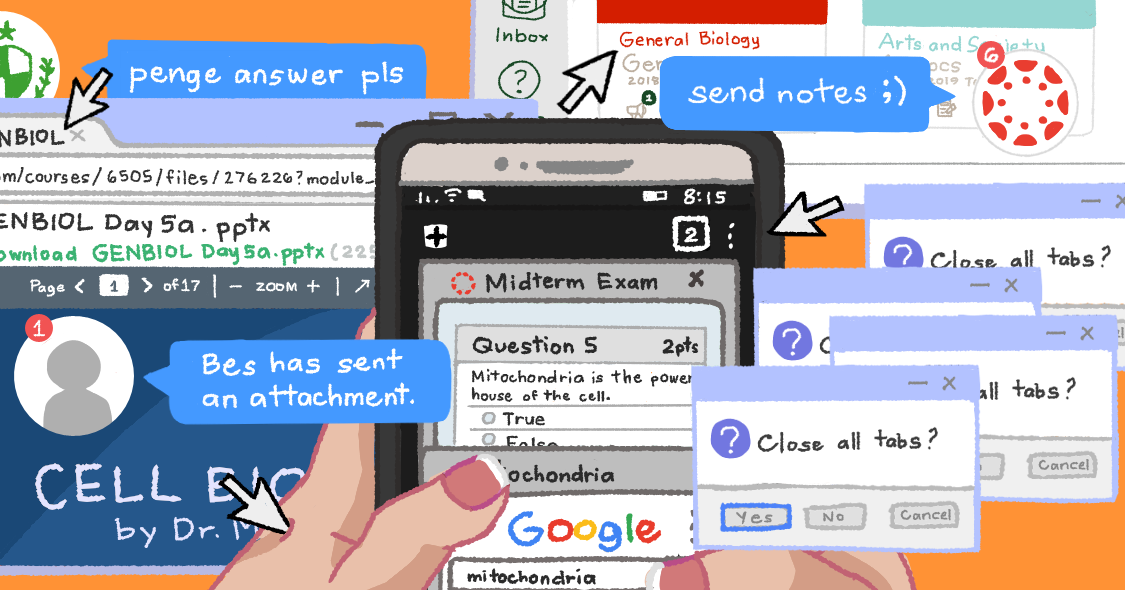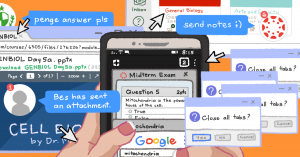

Last academic year 2017-2018, De La Salle Lipa (DLSL) started implementing the Learning Management System (LMS) app called Canvas which is a virtual extension of the classrooms in all educational levels in the institution featuring module sharing, academic discussions, and real-time announcements. However, after a year of using Canvas, it is no big secret that the students themselves have learned how to utilize it for cheating purposes in online exams or quizzes, and are taking advantage of the convenience of this digital platform to assure excellent grades.
There are many versions of these cheating techniques that are happening and will continue to happen unless some measures are taken to restrict them. These are just some of the most common situations that are very easy for students to cheat at:
True or False Questions. We all breathe a sigh of relief when we find out that our quiz consists just of true-or-false items instead of asking for an essay. After all, in a true-or-false, there’s always just a fifty-fifty chance of getting the answers right even if you didn’t study for it. But what if you could eliminate the risk completely and get your chances up to a hundred percent? After all, with a little common sense, we can just create a new tab redirecting to Google. Then with a simple right-click a student can copy and paste the question and within a second is given enough links to confirm whether the statement is true or isn’t. Some harder questions might require the student to do a little in-depth reading from the list of links, but either way, the clues always pop up. True or false, Google knows.
Identification Type. Some students hate this type of quiz and some students love it for the simple reason that it only requires memorization skills to answer every question correctly. There are no choices or any other hint, just a straightforward statement or question that requires a specific answer. But with Canvas, the student no longer has to resort to memorization as all the handouts and notes can be opened while taking the online quiz. After reading the question with just a couple of seconds of browsing the handouts – finding the answer requires almost no effort. Perfect score.
Screen capture. Making secrets notes or other forms of a kodigo during quizzes is one of the oldest and most common forms of cheating among students. Throughout history, students have found creative places to hide their notes in, from writing on innocent looking scraps of paper to more elaborate hiding places such as under shoes or wrist watches. With Canvas quizzes however, students have found a simpler way of getting all the answers and distributing them to others within the class.
Take for instance a student answered the online quiz as the first taker of the exam in their circle of friends. After the quiz, the results are given to the student immediately along with the key to correction. By simply taking a screenshot of the key, the student now has a complete copy of the answers. From question one up to the last number, be it a true or false, identification, or multiple choice type of quiz – everything could be captured. Then the student will simply send the screenshot to his or her circle of friends who are already waiting for the answers. Now, when it is their turn to take the quiz, a perfect score can be guaranteed again.
Absence of Proctors. In every quiz, there should always be someone who will supervise the students in the exam room. A proctor will be the one to keep an eye on all students to discourage cheating in any form possible. However, with Canvas, proctors are no longer around to check on every act of the students. Students are completely free to cooperate and share answers with one another.
Since two heads are better than one, an entire class taking the quiz as one will of course be superior. During the non-contact hours of class, students would simply sit in a circle s if a recollection will happen, using their Cloud chairs that are easy to move, with the purpose of passing the answers around the whole class. Like a pass-the-message game perhaps, this system assures that no one will be left behind in the quiz. Different tasks can be delegated among the class as well: One will be assigned for getting the first set of questions, the second one will be searching for answers in their notes or online, the next would verify the answer and the last one would be assigned for disseminating the information among the others – a vicious cycle of innovative class cheating.
During the first semester of the implementation of Canvas, teachers seemed to be clueless on how to decrease acts of cheating among students while taking quizzes online. This in turn created a mindset to the students that using notes and searching over the net for answers have become somehow acceptable. It seemed as if cheating is being tolerated, almost explicitly. What is the point of having a quiz if the answers are just right in front of the students? This form of learning assessment is just not reliable in any way.
“As the institution seeks to uphold the vision and mission of being an excellent educational institution by equipping the students with not just knowledge but also ethical virtues as future professionals, it should be more careful with innovations that are prone to acts of cheating and dishonesty.”
Given these accounts, I don’t think that the system of grading with Canvas can be considered credible. As the institution seeks to uphold the vision and mission of being an excellent educational institution by equipping the students with not just knowledge but also ethical virtues as future professionals, it should be more careful with innovations that are prone to acts of cheating and dishonesty.
“If innovation means breaking the values of honesty and integrity then, I would rather stick to the traditional pen and paper mode of taking quizzes because at least it is more just and somehow fair.”
If innovation means breaking the values of honesty and integrity then, I would rather stick to the traditional pen and paper mode of taking quizzes because at least it is somehow more just and fair. As Lasallians, and as students in general, we are in school not just to attain good grades but at the same time, to develop values which would mold and define our characters as we prepare for our careers.
The main goal of Canvas is to make the quizzes and modules accessible to students anytime and anywhere. But easy access to quizzes, on the other hand, also means easy access to answers. Going digital is an innovative way to cope with the changing way of evaluating learning but it is also an innovative way for students to accomplish tasks with just a click away to getting the answers.
“Going digital is an innovative way to cope with changing way of evaluating learning but also an innovative way for students to accomplish tasks with just a click to answers.”
For the second semester of implementation, a noticeable improvement regarding the matter was introduced. One of the features that some professors started to use was restricting access to the answer key until everybody had taken the quiz. The answers would only be revealed in class and in this case, when any of my classmates have petitions or questions regarding the result, it can raised right then and there.
Aside from this, in order for their students to avoid being tempted to individually copy and then paste the questions and search for answers in search engines, teachers should also consider setting an average duration for each quiz. The longer the time available for searching for answers, the higher the possibility of being tempted to cheat. Lastly, teachers may also consider turning on the setting to jumble the questions for every taker of the exam. By this, students will not be able to chit chat the questions that easily to other takers. This however, will only limit acts of cheating and are not completely foolproof measures.
Going online is not a pitfall but rather it should be a platform that when maximized will lead to a better way of evaluation of learning. The traditional way of teaching has its own advantages and drawbacks as does the digital mode have with respect to the process of transition and implementation per se. Nonetheless, these adverse scenarios should also be considered if our institution is ever going to fully shift into this kind of assessment.
Given also the fact that Canvas is now in its second year of implementation, these cheating instances should be addressed not just by the proponents but more importantly, the teachers who are utilizing the platform. Teachers should be far more innovative to foresee the acts of cheating that the students are doing while using as well the platform. Pointing fingers would not make these instances any better but at least identifying each others’ role in addressing such acts could change something about the matter.


Canvas may have it’s flaws. However, there are two sides of the coin. If what you state are facts, then it also shows the flaws of students. You talked about the values of honesty and integrity, and would claim that traditional pen and paper with a proctor better does that. I beg to disagree since authentic integrity and honesty are tested when nobody else is watching. A person of integrity cannot be tempted by advantages and gain of the moment. When a student is overruled by an honesty to oneself even if he/she fails in a simple quiz, I will have to say that that student has deep convictions of honesty and thereby has integrity. All exams and quizzes on canvas, therefore is an authentic test of integrity and honesty.
I agree! Ang sakit sa puso kapag ikaw na nga tong nagaral ikaw pa tong pinakamababa tapos sila itong nagsasaya kasi pare-parehas silang matataas (sobrang nasasad ako hanggang gabi seryoso) pero wala ka magawa (hahahahhaha) tawa na lang 🙂